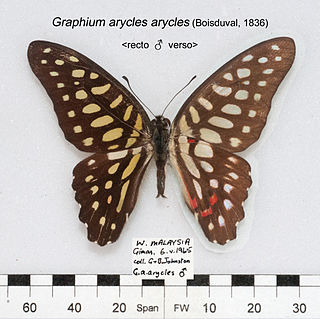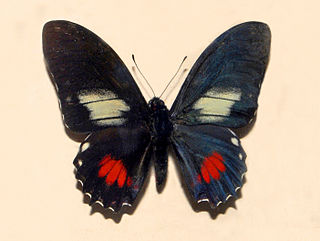
Papilio (Chilasa) epycides, the lesser mime, is a swallowtail butterfly found in India and parts of South-East Asia. The butterfly belongs to the mime (Chilasa) subgenus or the black-bodied swallowtails. It is a mimic of a common Indian Danainae, the glassy tiger butterfly.

Graphium arycles, the spotted jay, is a species of butterfly of the family Papilionidae found in the Indomalayan realm.

Graphium angolanus, the Angola white lady, is a species of butterfly in the family Papilionidae (swallowtails). It is found in Sub-Saharan Africa.

Graphium antheus, the large or larger striped swordtail, is a species of butterfly in the family Papilionidae (swallowtails), found in tropical and sub-Saharan Africa.

Papilio scamander, the Scamander swallowtail, is a butterfly of the family Papilionidae. It is found from eastern and south-eastern Brazil south into Argentina.

Papilio torquatus, the torquatus swallowtail, is a swallowtail butterfly in the subfamily Papilioninae. It is found from northern Argentina to Mexico.

Papilio cacicus is a Neotropical butterfly of the family Papilionidae first described by Hippolyte Lucas in 1852. It is found in Colombia, Venezuela, Ecuador and Peru.

Papilio zagreus is a butterfly of the family Papilionidae (swallowtails). It is found in South America, including Venezuela, Colombia, Ecuador, Peru, Bolivia and western Brazil.

Mimoides ariarathes is a species of butterfly in the family Papilionidae. It is native to South America.

Mimoides thymbraeus, the white-crescent swallowtail, is a species of butterfly in the family Papilionidae. It is found from Mexico to El Salvador and Honduras, where it is widespread and common.

Battus belus, the Belus swallowtail is a species of butterfly from the family Papilionidae that is found in Brazil, Colombia, Guatemala, Peru and Venezuela.

Parides bunichus is a butterfly of the family Papilionidae. It is found in Brazil, Paraguay, Argentina and Uruguay.

Papilio birchallii is a species of Neotropical swallowtail butterfly from the genus Papilio that is found in Colombia, Panama and Costa Rica.

Graphium bathycles, the veined jay, is a butterfly in the family Papilionidae, that is found in the Indomalayan realm.

Mimoides xeniades is a butterfly in the family Papilionidae. It is found in southern Bolivia, Ecuador, Colombia and Peru.

Mimoides euryleon, the false cattleheart swallowtail, is a species of butterfly in the family Papilionidae.

Mimoides lysithous is a species of butterfly in the family Papilionidae. It is found in the Neotropical realm.

Mimoides pausanias, the Pausanias swallowtail or bluish mimic-swallowtail, is a species of butterfly in the family Papilionidae.

Mimoides protodamas is a species of butterfly in the family Papilionidae. The common name is false polysticto, with reference to the similarity of this species with Battus polystictus.

Eurytides calliste is a species of butterfly in the family Papilionidae. It is found in the Neotropical realm.





















